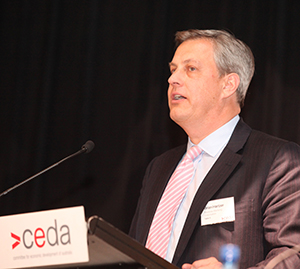
More attention to unconscious bias, not quotas is what's needed to progress more women into leadership positions, Westpac, Australian Financial Services, Chief Executive, Brian Hartzer told a CEDA audience in Sydney.
"My experience suggests that unconscious bias deserves much more attention than it has received to date," he said.
"In my experience, very few men are consciously bias against the advancement of women. On the contrary many, if not most, senior men in corporations want to do what they can to support women."
However, from what I've seen, they don't make the right choices and are tripped up by unconscious bias in three ways, he said.
"One, they've inadvertently contributed to work practices which make women feel excluded," he said.
"Two, they develop candidate pools in ways that overlook important sources of high quality female candidates.
"And three and most importantly, they select candidates based on a model of what they think is needed to be successful, not realising that their model is based solely on their experience of males in those roles.
"So the solution is not necessarily how women need to change, it's about how organisations need to work harder to address their work practices and remove unconscious bias.
"Too many women are not being promoted or are not being hired in the first place."
In addition, he said, too many women are opting out of roles or career progression due to family responsibilities because of inflexible work practices that have been set by men which make it difficult for them to feel included and achieve their potential.
Mr Hartzer said from Westpac's experience quotas are not necessary to move more women into senior leadership roles.
"Genuine intent combined with stretching targets and a clear focus on removing unconscious bias can make a real difference," he said.
"As an employer, we set the target of having, in our workforce (and) in our leadership roles, 40 per cent women, and we achieved that target last September - two years ahead of our schedule.
"This year, we've set a new target of having women in 50 per cent of our leadership positions by 2017."
Non-Executive Director, Primary Health Care, Adelaide Brighton, Lend Lease Investment Management and Pacific Brands Group, Arlene Tansey said whether targets or quotas are used to increase the number of women in leadership positions, the key is analysis and measurement.
"Whether it's a quota or a target, to me it's irrelevant. What's important is that you measure it and we, as the business community, are truly accountable," she said.
"If we can do that ourselves then targets will work, if we can't then quotas can do it for us.
"We must elect to change ourselves. Whether you call it a target or you call it a quota, there's no doubt that when you set a goal and measure it, it has a better chance of success.
"After many years of observing persistently low numbers of women in executive positions, despite policies galore, I reluctantly accept that we must do something more to improve diversity of thought through gender balance.
"I don't think there is a plot to keep women out of executive roles or the boardroom, but there is a stubbornly lower level of women participating at executive and board levels in Australia.
"Having said that, it is difficult to fill the boardroom or the senior executive with qualified female candidates when the pipeline only delivers one in 10.
"To address the pipeline each business must understand where participation levels decline and why.
"Targets and quotas can be a tool to drive the analysis that's required to design and implement changes needed to implement the best and the brightest women and men over time."
NSW Minister for Women Pru Goward said while Australia has made progress towards women's participation in the workforce, the talent pipeline is being hindered because the number of women in full time employment has barely changed in 40 years.
"In 40 years we have gone from 28 per cent of women in the full-time workforce to 36," she said.
"In the most productive years in the workforce, the years when promotion is possible and where promotion is necessary, that is where you will find a very low percentage of women in full time work.
"There's no doubt that we do need to take action to move to a system where gender representation and participation is present at all levels in organisations and that is about the pipeline.
"Only having 36 per cent of your full time workforce female is a challenge because that's your pipeline for senior executive positions and leadership positions.
"I favour meritocracy with the assistance of voluntary targets and with a consciousness that this is a challenge we need to meet, not an abstract quota.
"Sure, (a quota system) forces diversity but it can engender resentment, opposition and doubtless organisations will develop means of playing with the requirements that they find don't suit their ambitions.
"If it's not developed in conjunction with attitudinal shifts then that sort of legislation is inevitably rejected by the public."
Pottinger, Joint CEO, Cassandra Kelly said the main factor that defines a woman's view on mandatory quotas is how long they are prepared to wait and see the same outcome.
"I have yet to meet a woman who would be prepared to wait for another generation to see equality in management and the boardroom," she said.